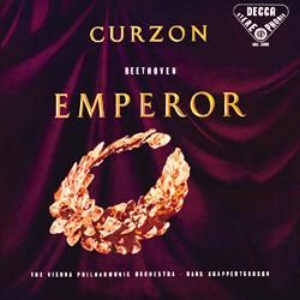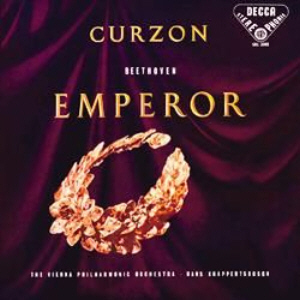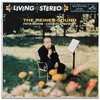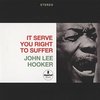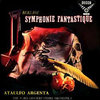AAA 100% Analogue This LP was Remastered using Pure Analogue Components Only from the Master Tapes through to the Cutting Head
Speakers Corner / Decca SXL 2002 - 180 Gram Virgin Vinyl - AAA 100% Analogue
Limited Edition - Pure Analogue Audiophile Mastering - Pressed at Pallas Germany
Speakers Corner 25 Years Pure Analogue This LP is an Entirely Analogue Production
Beethoven: Concerto No. 5 for Piano and Orchestra “Emperor” - Sir Clifford Curzon, Vienna Philharmonic Orchestra conducted by Hans Knappertsbusch
I remember listening one afternoon to Curzon and Knappertsbusch play the Adagio un poco moto from Beethoven's Piano Concerto 5, the "Emperor" (LP, Decca/Speakers Corner SXL 2002, one of the loveliest records ever made -Stereophile
Vienna Philharmonic Orchestra conducted by Hans Knappertsbusch
The Concerto No. 5 in E flat major for Piano and Orchestra, composed in 1809 at the time of Napoleon’s siege and occupation of Vienna, was Ludwig van Beethoven’s last work in this form. The heroic optimism at the heart of the Concerto finds expression in the majesty of its design and the innovative virtuosity of the solo part. The dialect between piano and orchestra creates an electric atmosphere of brooding depth and sweeping grandeur. Beethoven’s choice of key, the E-flat major, was not arbitrary but gave voice rather to the wild pathos in his own soul.
Clifford Curzon’s interpretation of the score is intelligent and refined, his execution characterized by introspective discipline.
The exemplary interplay between Curzon and Hans Knappertsbusch evokes the chiaroscuro latent in each of the Emperor’s three movements. The Vienna Symphony Orchestra displays its customary brilliance throughout.
This DECCA recording, one of the very earliest in stereo, is convincing both musically and tonally. More than a document, it is a milestone in musical history.
I remember listening one afternoon to Curzon and Knappertsbusch play the Adagio un poco moto from Beethoven's Piano Concerto 5, the "Emperor" (LP, Decca/Speakers Corner SXL 2002, one of the loveliest records ever made -Stereophile
I wonder who decided to hand Knappertsbusch the baton for this
recording of Beethoven's last piano concerto with Clifford Curzon. His
uninspired direction taints a performance that could otherwise have been
an enlightening recording of Ludwig's 1809 testament to the genre.
Beethoven's Fifth is filled with optimism and bravery, composed when
Napoleon loomed large at the doors of Vienna. But don't look for these
potent sentiments in Knappertsbusch's direction of a tired and
unenthusiastic Vienna Philharmonic Orchestra. Knappertsbusch was
known for his live operatic performances and his absolute aversion for
studio recordings. Well, here it shows. He leaves Curzon alone with the
mission to make this an interesting performance and the British pianist
actually manages more than once to pull the whole together thanks to his
original rhythmic contrasts in the first and third movement. As is often the case, the introspective and intellectual Curzon is at his best in the slow movement and the "Adagio un poco moto" gives him fantastic material to express his lyrical talent but there again the emotional support from the orchestra is pretty close to non-existent. Despite the great re-mastering job by Speakers Corner, this recording does show some of its age, with the lower register of the piano sounding dulled and the strings a bit more strident than desirable. The fact that this recording, one of the very first stereo recordings ever made, still sounds this credible is fantastic testimony to the quality of the original take. While the sound quality can't quite compare to recordings made a decade later, it is far better than anybody should reasonably expect 6 Moons
Musicians:
- Sir Clifford Curzon
- Vienna Philharmonic Orchestra
- Hans Knappertsbusch (conductor)
Recording: June 1957, Sofiensaal, Vienna by Gordon Parry
Production: Erik Smith
The Vienna Philharmonic Orchestra. Hans Knappertsbush (conductor). The Concerto #5 in E-flat major for Piano and Orchestra, composed in 1809, was Ludwig van Beethoven's last work in this form. More than a document, it is a milestone of our musical history.
Selections:
Concerto No. 5 in E Flat Major for Piano and Orchestra, Opus 73.
25 Years pure Analogue
Are your records completely analogue?
Yes! This we guarantee!
As a matter of principle, only analogue masters are used, and the necessary cutting delay is also analogue. All our cutting engineers use only Neumann cutting consoles, and these too are analogue. The only exception is where a recording has been made – either partly or entirely – using digital technology, but we do not have such items in our catalogue at the present time
Are your records cut from the original masters?
In our re-releases it is our aim to faithfully reproduce the original intentions of the musicians and recording engineers which, however, could not be realised at the time due to technical limitations. Faithfulness to the original is our top priority, not the interpretation of the original: there is no such thing as a “Speakers Corner Sound”. Naturally, the best results are obtained when the original master is used. Therefore we always try to locate these and use them for cutting. Should this not be possible, – because the original tape is defective or has disappeared, for example – we do accept a first-generation copy. But this remains an absolute exception for us.
Who cuts the records?
In order to obtain the most faithful reproduction of the original, we have the lacquers cut on the spot, by engineers who, on the whole, have been dealing with such tapes for many years. Some are even cut by the very same engineer who cut the original lacquers of the first release. Over the years the following engineers have been and still are working for us: Tony Hawkins, Willem Makkee, Kevin Gray, Maarten de Boer, Scott Hull, and Ray Staff, to name but a few.
At the beginning of the ‘90s, in the early days of audiophile vinyl re-releases, the reissue policy was fairly straightforward. Companies such as DCC Compact Classics, Mobile Fidelity, Classic Records and others, including of course Speakers Corner, all maintained a mutual, unwritten code of ethics: we would manufacture records sourced only from analogue tapes.
Vinyl’s newfound popularity has led many other companies to jump on the bandwagon in the hope of securing a corner of the market. Very often they are not so ethical and use every imaginable source from which to master: CDs, LPs, digital files and even MP3s.
Even some who do use an analogue tape source employ a digital delay line, a misguided ’80s and ‘90s digital technology that replaces the analogue preview head originally used to “tell” the cutter head in advance what was about to happen musically, so it could adjust the groove “pitch” (the distance between the grooves) to make room for wide dynamic swings and large low frequency excursions. Over time analogue preview heads became more rare and thus expensive.
So while the low bit rate (less resolution than a 16 bit CD) digital delay line is less expensive and easier to use than an analogue “preview head”, its use, ironically, results in lacquers cut from the low bit rate digital signal instead of from the analogue source!
Speakers Corner wishes to make clear that it produces lacquers using only original master tapes and an entirely analogue cutting system. New metal stampers used to press records are produced from that lacquer. The only exceptions are when existing metal parts are superior to new ones that might be cut, which includes our release of “Elvis is Back”, which was cut by Stan Ricker or several titles from our Philips Classics series, where were cut in the 1990s using original master tapes by Willem Makkee at the Emil Berliner Studios. In those cases we used only the original “mother” to produce new stampers.
In addition, we admit to having one digital recording in our catalogue: Alan Parsons’ “Eye in the Sky”, which was recorded digitally but mixed to analogue tape that we used to cut lacquers.
In closing, we want to insure our loyal customers that, with but a few exceptions as noted, our releases are “AAA”— analogue tape, an all analogue cutting system, and newly cut lacquers.
60 Years Pallas
Audiophile Vinyl - Made in Germany For over 60 years the family business in the third generation of the special personal service and quality "Made by Pallas" is known worldwide. Our custom PVC formulation produces consistently high pressing quality with the lowest surface noise in the industry. Our PVC complies with 2015 European environmental standards and does not contain toxic materials such as Lead, Cadmium or Toluene. Our vinyl is both audiophile and eco-grade!
